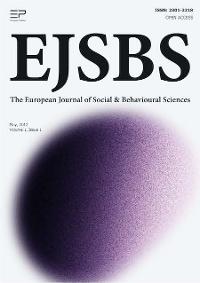Abstract
Teachers are facing now the influences of the information society and the problems of teaching the so called „net-generation”. The institutions try to adapt to these challenges by developing of digital learning modules, and adequate infrastructure. The students’ attitude toward e-learning was measured in two phases, in 2006 and 2010. CARS for measuring anxiety during working with computers. CAS measures Computer confidence and liking and achievement. There was difference between the students’ attitude (liking, confidence and achievement) in the two periods. The ‘net-generation’ has a less favourable attitude toward computers, than students of the year 2006. Gender difference also occurred, we found that men show better attitude toward computers in both samples. Both men’ and women’ results on Computer confidence subscale were the highest. There was difference in the age groups’ attitude components. 20-30-year-old student in the 2006 sample showed the most unfavourable, while 31-40-year-old student attitude is the most favourable. We found difference in students’ computer attitude depending on e-learning experience. The more the students experience is the more favourable their computer attitude is. The computer anxiety is significantly higher in the 2010 sample, women’ anxiety is also higher and in both sample the anxiety is decreases with e-learning experience. We find difference in the 2006 sample the 20-30 year-old group showed the highest level of anxiety, and the 31-40 year-old group anxiety was the lowest.
Keywords: CARS, CAS, e-learning, computer anxiety
Introduction
All we are facing now the influences of the information society in our everyday life. One aspect of this changing life is, the so called “net-generation”- those young people, who were born between 1982 and 1991 – who learn and communicate different way than their parents, teachers. The main source and medium of their knowledge and interaction is the Internet and the mobile world – they are almost always “plugged or logged in”.
Education tries to adapt to these challenges with development of digital learning modules, online courses, adequate infrastructure and ICT-competent instructors. However, these attempts are many times unsuccessful, new methods fail to integrate into the school curricula.
There are considerable differences between generations in the relation to the Internet. While the younger, not so experienced and mature „net-generation” is familiar with the usage of tools and software, the “older generation” with more experiences in other aspects of life need more time to accept and learn the new technologies. Both generations advantages are essential to the effective development.
This generation-gap occurs between students and teachers as well. Thanks to Marc Prensky (2001) we have the very expressive distinction of “digital natives” and “digital immigrants”. “Digital natives” – students - were born into the new technology which influenced their information processing and thinking, they have the advantage of being “native speakers of the digital language of computers, video games and Internet” (Prensky, 2001, p. 1). “Digital immigrants” – teachers – only try to adapt to this new environment, try to learn this new digital language. The result is “digital accent” from teachers’ side and problems in communication and teaching between teachers and students. Educators possible solution is flexibility: application of new methodology and interpretation of contents in new interesting and understandable teaching design.
Primary aim of the research is to compare students’ attitude toward e-learning considering age, gender and e-learning experience. Comparing results of two investigations (in 2006 and 2010) we try two highlight differences in the concepts about and relation to the e-learning course of this two student groups.
Traditional research on attitudes applies Likert-type scales that measuring cognitive aspect of the attitudes. Here we decided to investigate the student attitude toward e-learning with methods (Semantic differential scale and Images or word association technique) that give the opportunity of revealing not only cognitive but also emotional component of attitude as well.
Factors influencing attitudes toward information technology
There are two main directions in the investigation of attitude toward information technology: one is the acceptance of information technology, the other is the perception of self-efficacy.
According to Davis’s (1989) Technology Acceptance Model, “perceived usefulness” (e.g. faster, easier, more productive, effective work with higher performance) and “perceived ease of use” (e.g. ease of learning, become skillful, understanding, amount of mental effort, control, flexibility) are critical factors that predict the intention to use technology. For example, Miller et al. (2003) found that there is significant association between these two factors and time spent in the e- learning courses.
Attitude toward information technology is also influenced by the perceived self-efficacy. Mediating factors are: computer anxiety, computer confidence and computer-liking. Computer anxiety is the fear of using of or interacting (or only intention of it) with computers. Fardal és Tollefsen (2004) found that more than
50% of students report anxiety during IT usage in higher education. Researchers found that the level of performance is independent of anxiety, but anxious student spend more time with tasks and computer self-efficacy is in negative correlation with computer anxiety. Computer self-efficacy is confidence in the ability of successful computer use. This belief influences undertaking tasks, effort and persistence in tasks that are in connection with information technology. Consequently, computer anxiety is the antecedent of computer self-efficacy belief, (Fardal és Tollefsen, 2004) at the same time perceived self-efficacy influences the attitude to IT. Computer anxiety effects learning and training computer skills and performance as well (Sam et al., 2005).
Computer confidence (belief that able to use /learn/computers) and computer liking (enjoyment of working with computers) represent favourable aspects of attitude toward computers.
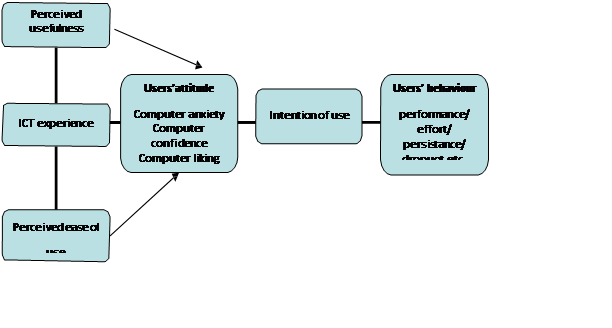
Valenta et al. (2001) summarised positive and negative aspects of application of technology in distance learning. Positive aspects are greater flexibility, improved access/interaction with the instructor, collaborative learning environment, positive learning experience, better grades. Negative aspects are reduced amount of face-to- face interaction, technological problems, increased workload, costs, need of technical, administrative supports.
Further results according to attitude toward e-learning: gender and age differences
There are contradictory results about gender differences of attitude toward and confidence with IT, but controlling computer experience these differences disappear. There are differences in computer usage style and performance between women and men: e.g. forums are used by men for information change, while by women for consensus making and communication with teachers and “classmates”; women’ learning is more focused, while men jump in the material, they learn “any time”. Women have better grades on online courses (more effective): they are more focused while learning, spend more time with learning, tend to follow instructions, organize better their sources during courses, they are more flexible, than men. (Busch, 1995; McSporran & Young, 2001; Ory et al., 1997; Sam et al., 2005)
Comparing age groups researchers found that with age there is lower level of effectiveness in computer usage as a result of less experience (Czaja & Sharit, 1998; Joy, 2004)
But both gender and age differences show that the computer experience has effect on the attitude toward computers. The attitude is better if the user has more experience.
Research Hypothesis
Differences of 2006 and 2010 students
Hypothesis I. Students of the two periods (2006 and 2010) have different concepts about e-learning as the result of different computer experiences/ familiarity with computers.
Hypothesis II. The basis of the students’ favourable attitude toward e-learning is different in the two periods.
Hypothesis II/1. More favourable attitude toward e-learning of the students of 2010 period is the result of the higher technical skills of this age group.
Hypothesis II/2. More unfavourable opinion of the students of 2006 period is the result of the higher computer anxiety (relative unfamiliarity of the group with impersonal, complicated technology).
Differences with e-learning experience
Hypothesis III. In both periods (2006, 2010) the anxiety toward e-learning decreases with computer experience.
Gender differences
Hypothesis IV. There are gender differences between associations to e-learning. Hypothesis IV/1.
Women prefer organization and self-directed time schedule of e-learning
Hypothesis IV/2. Men prefer interactivity and technical variety in e-learning
Research methodology
We measured components of students’ attitude toward e-learning in two phases. In the first phase (in 2006) we investigated students’ attitude toward traditional (before lecture) and e-learning (after lecture) education in a blended-learning course via paper-and-pencil questionnaires. In the second phase (in 2010) students of an e-learning course were asked about e-learning via online questionnaires after completing the course.
Sample
Students of Corvinus University of Budapest participated in the research in both phases.
Research instruments
Semantic differential scale (Osgood, et al 1957)
The subject provides ratings of stimuli on a set of positive – negative adjective pairs. After factor analysis ratings can be averaged or summed to obtain an overall affective score.
Images or word association technique (Slovic et al. 1991)
Aim: to reveal cognitive and affective elements of images people hold about complex stimuli: presenting subject with a target stimulus (here: traditional learning and e-learning in the first phase and e-learning in the second phase) and asking them to provide the first thought or image that comes into their mind. The process is then repeated a number of times. Subjects are then asked to rate each image on a scale ranging from very positive (e.g.+2) to very negative (-2) with a neutral point in the middle. After that we summing/averaging the ratings to obtain an overall imaginary index. Further content analysis is applied to identify the theme-categories in the associations as well. The advantage of this methodology is that respondent is free to express images in his/her natural language term.
Computer Anxiety Rating Scale (Heissen et al, 1987 q. Sam et al, 2005)
This scale was used for measuring anxiety during working with computers.
Computer Attitude Scale (Bandalos and Benson, 1990 revised form of CAS by Loyd & Gesard, 1985).
This Scale measures Computer confidence and Computer liking and Computer achievement.
Results
Data were analysed by SPSS 17.0. Descriptive statistics were calculated for different scales. Semantic differential Scale was analysed by cluster analysis and factor analysis (Principal Component Analyses with Varimax Rotation, Eigen value over 1) to identify components. T-tests and ANOVA analysis of means was carried out to compare groups (phases, age, gender, computer experience).
Results of Images or word association technique
We compared students’ attitude toward e-learning in the two phases (2006 and 2010) in the overall sample. One sample T-test was carried out to test the differences with regard the average ratings of the two groups.
There is significant (p=0.016) difference between the students’ attitude toward e- learning in the two periods. Net-generation has more favourable attitude toward this learning method, than students of 2006 year.
The content analysis (with help of ATLASti program) revealed the following content categories in the associations to the e-learning:
Technology, tools
- Traditional distance learning
- Negative attributes
- Positive attributes
- Teaching methods
- Interactivity
- Advantages of the learning form
In both phases the most frequently sited associations belonged to the positive attributes category, in 2006 this is followed by advantages, technology and negative attributes, while in 2010 teaching methods, advantages and interactivity are the next three association-content.
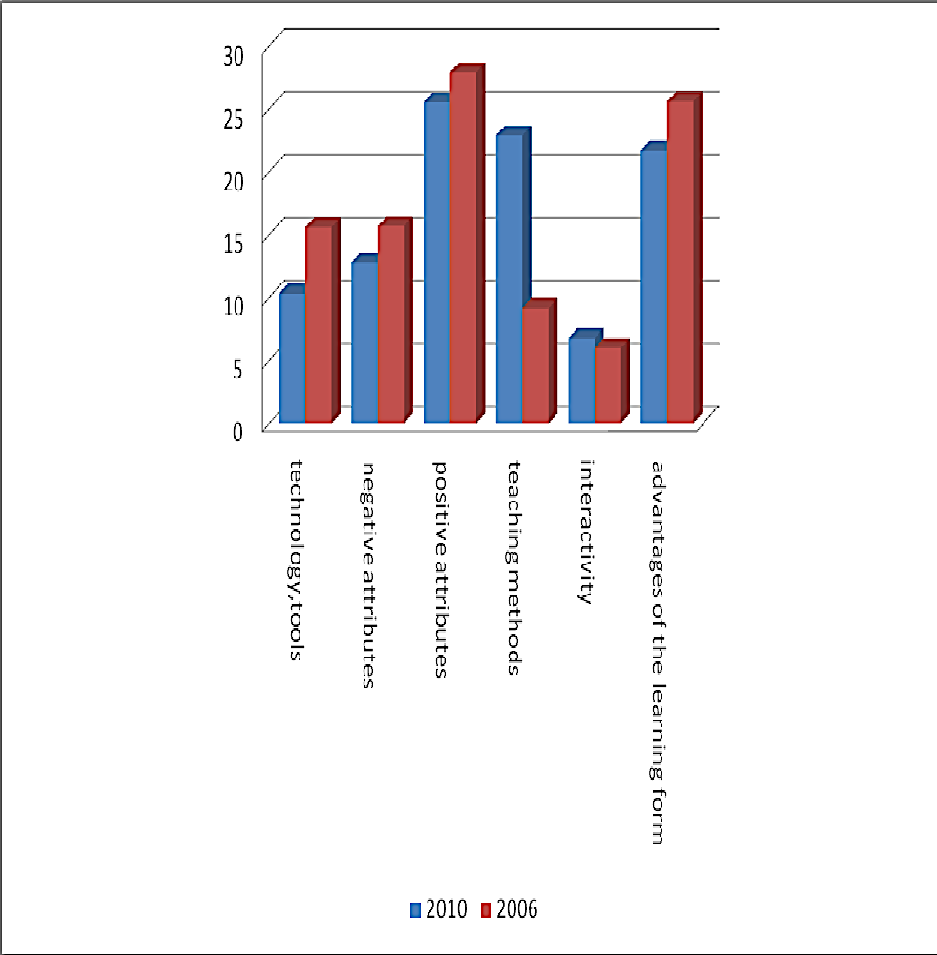
There was no significant difference between groups of age, gender and educational level.
Results of semantic differential scale
First, we compared the semantic meaning of e-learning in the two phases of investigations. Averaging the answers on -3 to +3 adjective-pairs scales we could present the most salient categories.
Five years ago, students emphasised the unfamiliarity and impersonal aspects of e- learning, while in 2010 this aversion disappeared, learning via computers seems to be an accepted way for students.
With help of cluster analysis we obtained the semantic differences on the picture students hold about e- learning.
Students attitude toward e-learning was ambivalent in the first phase: it is one- sided, discouraging, boring but effective, capable. While in 2010 the picture has changed: only one unfavourable attribute – insensitivity remained, all other characteristics have positive aspects: organized, inventive and predictable.
Factor analyses of the data revealed the following factors (adjectives/ attributes that go together) in students’ thinking about e-learning.
Factors reflect similar dimensions in students’ concept about e-learning, but in 2006 group this attitude is unfavourable, while students of 2010 emphasis favourable aspects: organization and innovation besides negative aspects (impersonal, directing) of the method. One possible interpretation of this later result is that computer usage alone without reforming pedagogical methods may elicit adverse reactions from student (e.g. higher anxiety).
Comparing factor structure of students with e-learning experience and with only traditional education background we found significant (p<0.01) differences in two factors. Students without e-learning experience in the 2010 sample think that secure stability and discipline of e-learning is higher than students in the 2006 sample. Comparing students’ opinion with e-learning background of 2006 and 2010 sample we found that 2010 students think that e-learning is more changing and undisciplined.
Furthermore, we found that men tend (p=0.075) to refuse „boring” mutuality of traditional learning comparing with women, while women significantly (p=0.05) do not appreciate as much as men the possibility of self-direction in e-learning in the 2006 sample.
Gender difference occurred in the 2010 sample also. Women opinion was that e- learning is undisciplined while men considered it to be more disciplined.
Results of Computer Anxiety Rating Scale and Computer Attitude Scale
There was difference (p<0.05) between the students’ attitude (liking, confidence and achievement) in the two periods. The ‘net-generation’ has a less favourable attitude toward computers, than students of the year 2006.
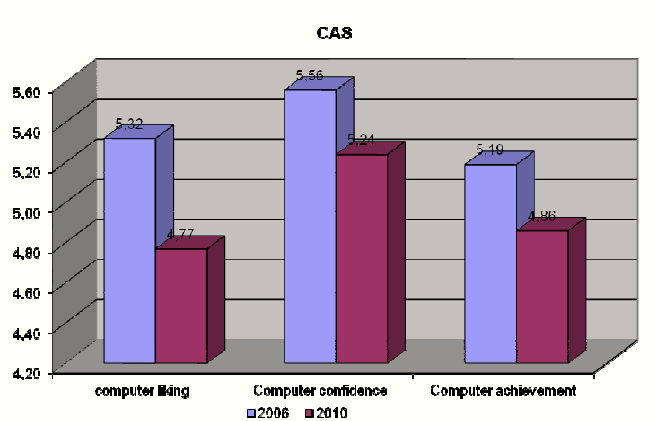
Gender difference also occurred, we found that men show better attitude toward computers in both samples. Both men’ and women’ results on Computer confidence subscale were the highest.
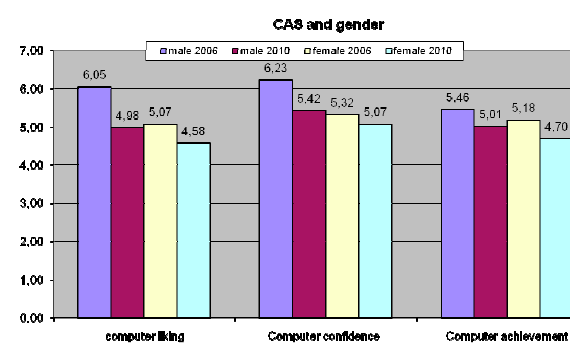
There was difference (p<0.05) in the age groups’ attitude components. 20-30 year-old student in the 2006 sample showed the most unfavourable, while 31-40 year- old student attitude is the most favourable.
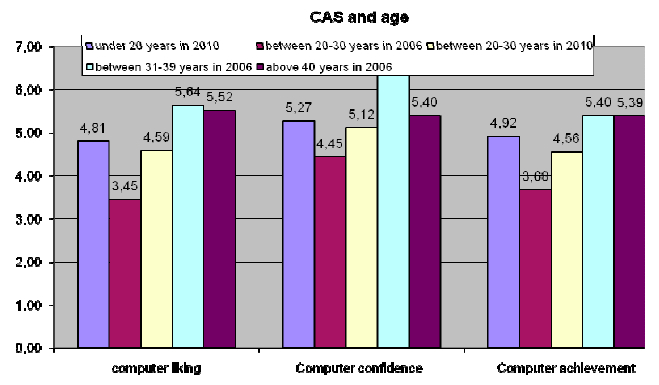
We found difference (p<0.01) in students’ computer attitude depending on e- learning experience. The more the students experience is the more favourable their computer attitude is.
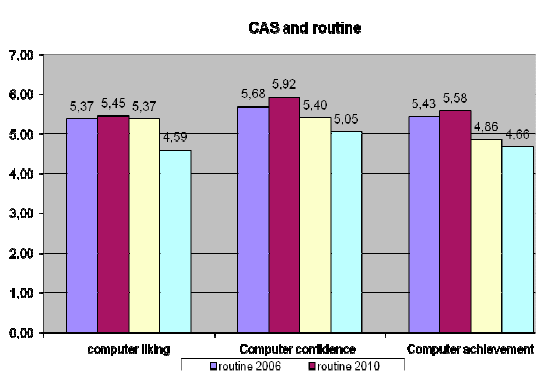
The computer anxiety is significantly (p=0,007) higher in the 2010 sample, women’ anxiety is also higher and in both sample the anxiety is decreases with e- learning experience. We find difference in the 2006 sample the 20-30 year-old group showed the highest level of anxiety, and the 31-40 year-old group anxiety was the lowest.
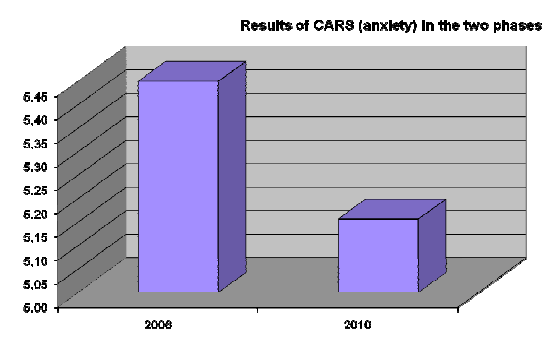
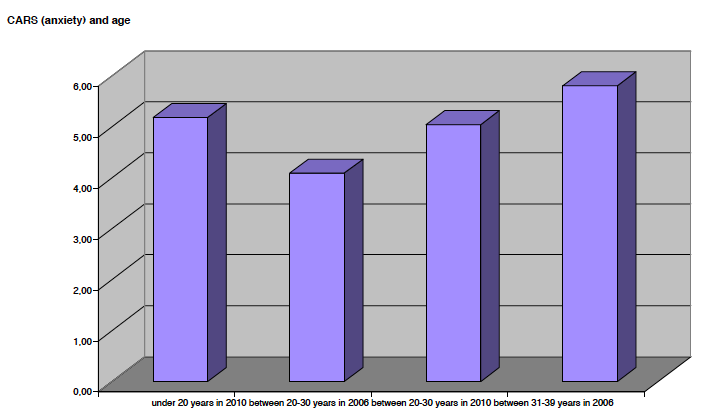
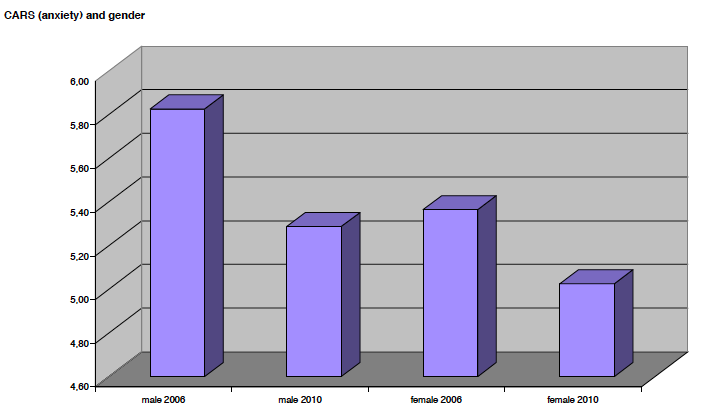
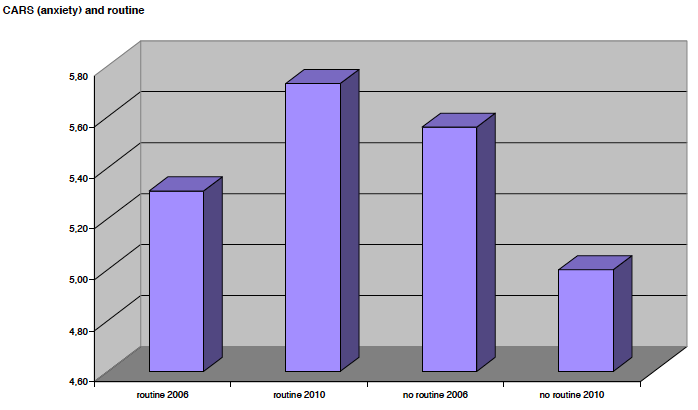
Conclusions, Implications
Comparing students’ attitude toward e-learning we found differences between the two samples. Students’ attitude was ambivalent in 2006, while in 2010 sample students emphasised favourable and promising aspects of this educational form: innovation, organization, predictability and playfulness.
Primary aim of our investigation was to study the attitude change toward e-learning over time (between 2006 and 2010 period) considering our results about ambivalent attitude we can make the following suggestions:
Students’ motivation should be based on the result that favourable attitude is effected by innovative side, organization and predictability of the e-learning. Men perceive self-efficacy and lower level of anxiety during e-learning courses, consequently the possible basis of their learning motivation might be using diverse technical solutions and playful methods. Women fear of unfamiliarity might be reduced with pre-course preparation, skill training, technical support and group work during courses.
Further sources of favourable attitude are:
Exact, thorough specifications and design of aims, requirements, feedbacks of e-learning courses.
- Reduction of impersonality and one-sidedness of the e-learning courses with providing possibility of interactions during courses (with instructor, cooperative methods).
- Increasing students’ involvement (experiences, contributions), possibility of “face”-formation and presentation are also possible way of elimination of impersonality (Torkzadeh et al., 1999).
Flexible learning material which is adaptable to different learner types might enhance the perceived self-efficacy of students.
Acknowledgements
The authors declare that there is no conflict of interest.
References
Busch, T. (1995). Gender differences in self-efficacy and attitudes toward computers. Journal of Educational Computing Research, 12, 147-158.
Czaja, S. J., & Sharit, J. (1998). Age differences in attitudes toward computers, Psychological Sciences and Social Sciences, 53, 329-340.
Davis, F. D. (1989). Perceived usefulness, perceived ease of use, and user acceptance of information technology. MIS Qaterly, 19(2), 89-211.
Fardal, H., & Tollefsen, H. (2004). Motivational factors in computer training: A literature review and a research model proposal Buskerud University College (Master Thesis) http://www-bib.no/tekster/div/fardal-tollefsen/hovedfogsavhandling-ferdig.pdf
Joy, D. (2004) Instructors transitioning to online education Dissertation, Falls Church, Virginia.
Mcsporran, M., & Young, S. (2001). Does gender matter in online learning? Association for Learning Technology Journal, 9(2), 3-15.
Miller, M. D., Rainer, R. K., & Corley, J. K. (2003). Predictors of engagement and participation ina n on-line course. Online Journal of Distance Learning Administration, 6(1).
Ory, J. C., Bullock, C., & Burnaska, K. (1997). Gender Similarity in the Use of and Attitudes About ALN in a University Setting. Journal of Asynchronous Learning Networks, 1(1).
Prensky, M. (2001). Digitális bennszülöttek, digitális bevándorlók. Retrieved from http://goliat.eik.bme.hu/~emese/gtk-mo/didaktika/digital_kids.pdf, 2009. 02. 20.
Sam, H. K., Othman, A. E. A., & Nordin, Z. S. (2005). Computer Self- Efficacy, Computer Anxiety, and Attitudes toward the Internet: A Study among Undergraduates in Unimas. Educational Technology & Society, 8(4), 205-219.
Slovic, P., Layman, M., Kraus, N., Flynn, J., Chalmers, J., & Gesell, G. (1991). Perceived Risk, Stigma, and Potential Economic Impacts of a High-Level Nuclear Waste Respository in Nevada. Risk Analysis, 11, 683-696.
Torkzadeh, R., Pflughoeft, K., & Hall, L. (1999). Computer Self- Efficacy, Training Effectiveness and User Attitudes: An Empirical Study, Behaviour and Information Technology, 18(4), 299-309.
Valenta, A., Theriault, D., Dieter, M., & Mrtek, R. (2001). Identifying student attitudes and learning styles in distance education. Journal of Asynchronous Learning Networks,5(2).
Copyright information

This work is licensed under a Creative Commons Attribution-NonCommercial-NoDerivatives 4.0 International License.


